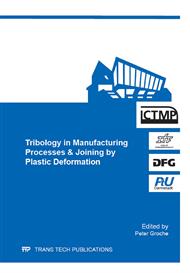[1]
Rojas-Campanur M., Lara-Romero J., Chinas-Castillo F., Alonso-Nunez G.: Tribological Performance of Rosin Acid Additives in Water Based Lubricants. Tribology Online 2, 9-33 (2007).
DOI: 10.2474/trol.2.29
Google Scholar
[2]
Cambiella A., Benito J.M., Pazos C.: Interfacial properties of oil-in-water emulsions designed to be used as metalworking fluids. Colloids and Surfaces A: Physicochemical and Engineering Aspects 305, 112-119 (2007).
DOI: 10.1016/j.colsurfa.2007.04.049
Google Scholar
[3]
Persson K., Gahlin R.: Tribological performance of a DLC coating in combination with water based lubricants. Tribology International 36(11), 851-855 (2003).
DOI: 10.1016/s0301-679x(03)00103-8
Google Scholar
[4]
Fang L., Gao Y., Zhang Z.: Tribology of Si3N4 with different glassy phase content sliding against grey cast iron lubricated with water. Wear 255-229, 896-904 (1999).
DOI: 10.1016/s0043-1648(98)00408-6
Google Scholar
[5]
Haibing M., Jing L., Huan Ch., Guangzhi Z., Yi Y., Tianhui R., Yidong Z.: XPS and XANES characteristics of tribofilms and thermal films generated by two P- and/or S- containing additives in water-based lubricant. Tribology International 42(6), 940-945 (2009).
DOI: 10.1016/j.triboint.2009.01.004
Google Scholar
[6]
Kajdas C.: Additives for metalworking lubricants - a review. Lubrication Science 1, 385-409 (2006).
DOI: 10.1002/ls.3010010406
Google Scholar
[7]
Takahashia K., Shitaraa Y., Kaimaia T., Kannob A., Mori Sh.: Lubricating properties of TR Gel-lube-Influence of chemical structure and content of gel agent. Tribology International 232, 250-256 (2010).
DOI: 10.1016/j.triboint.2010.01.016
Google Scholar
[8]
Landolt D., Mischler S., Stemp M.: Electrochemical methods in tribocorrosion: a critical appraisal, Electrochimica acta 46, 3913-3929 (2001).
DOI: 10.1016/s0013-4686(01)00679-x
Google Scholar
[9]
Tomala A., Karpinska A., Werner W.S.M., Olver A.V., Störi H.: Tribological performance of additives for water-based lubricants. Wear 269 (11-12), 804-810 (2010).
DOI: 10.1016/j.wear.2010.08.008
Google Scholar
[10]
Tomala A., Werner W.S. M, Gebeshuber I.C., Dörr N. and Störi H., Tribochemistry of monomolecular lubricant films of ethanolamine oligomers. Tribology International, 42, 1513-1518 (2009).
DOI: 10.1016/j.triboint.2009.06.004
Google Scholar
[11]
Jeyaprabha C., Sathiyanarayanan S., Venkatachari G.: Corrosion inhibition of pure iron in 0. 5 m H2SO4 solutions by ethanolamines. Applied Surface Science, 246 (1-3), 108-116, (2005).
DOI: 10.1016/j.apsusc.2004.10.044
Google Scholar
[12]
Fouda A.S., Moussa M.N., Taha F.I., Elneanaa A.I.: The role of some thiosemicarbazide derivatives in the corrosion inhibition of aluminium in hydrochloric acid. Corrosion Science 26(9), 719-726, (1986).
DOI: 10.1016/0010-938x(86)90035-1
Google Scholar
[13]
Ali S. A., Saeed M.T., Rahman S.U.: The isoxazolidines: a new class of corrosion inhibitors of mild steel in acidic medium. Corrosion Science 45 (2), 253-266, (2003).
DOI: 10.1016/s0010-938x(02)00099-9
Google Scholar
[14]
Arab S.T., Al-Turkustani A.M.: Corrosion Inhibition of Steel in Phosphoric Acid by Phenacyldimethyl Sulfonium Bromide and some of its p-Substituted Derivatives. Port. Electrochim. Acta 24(1), (2006).
DOI: 10.4152/pea.200601053
Google Scholar
[15]
Sathiyanarayanan S., Marikkannu C., Palaniswamy N.: Corrosion inhibition effect of tetramines for mild steel in 1M HCl. Applied Surface Science, 241 (3-4), 477-484, (2005).
DOI: 10.1016/j.apsusc.2004.07.050
Google Scholar
[16]
Dubey A.K., Singh G.: Corrosion Inhibition of Mild Steel in Sulphuric Acid Solutionby Using Polyethylene Glycol Methyl Ether (PEGME). Portugaliae Electrochimica Acta 25, 221-235, (2007).
DOI: 10.4152/pea.200702221
Google Scholar
[17]
Chen-Hung Liao, Meng-Hui Li: Kinetics of absorption of carbon dioxide into aqueous solutions of monoethanolamine + N-methyldiethanolamine,. Chemical Engineering Science 57 (21), 4569-4582 (2002).
DOI: 10.1016/s0009-2509(02)00395-0
Google Scholar
[18]
Vazquez G., Antorrena G., Navaza J. M., Santos V.: Absorption of CO2 by water and surfactant solutions in the presence of induced Marangoni effect. Chemical Engineering Science 51 (12), (1996).
DOI: 10.1016/0009-2509(96)85979-3
Google Scholar


